Destabilization of Indomethacin-Paracetamol Co-Amorphous Systems by Mechanical Stress
Abstract
:1. Introduction
2. Materials and Methods
2.1. Materials
2.2. Methods
2.2.1. Sample Preparation
2.2.2. Thermal Analysis
2.2.3. XRPD and VT-XRPD
2.2.4. Physical Stability Test
2.2.5. Construction of Phase Diagram and Tammann Diagram for Eutectic Mixtures
3. Results and Discussion
3.1. Eutectic Behavior Investigation on IND–PAR Systems
3.1.1. Eutectic Behavior of IND–PAR Systems Investigated by DSC
3.1.2. Eutectic Behavior of IND–PAR Systems Investigated by VT-XRPD
3.2. Influence of Mixing Ratios on CAMS Stability
3.3. Influence of Grinding on CAMS Stability—Investigated by Long-Term Stability Test and TGA
3.4. Influence of Grinding on CAMS with Different Mixing Ratios—Investigated by DSC and VT-XRPD
3.4.1. Influence of Grinding on Samples Containing Excess Components
3.4.2. Influence of Grinding on Samples with Optimal Mixing Ratio
3.5. Influence of Different Grinding Times on CAMS with Different Ratios—Investigated by DSC and XRPD
3.5.1. Samples Containing Excess PAR (30% IND–70% PAR)
3.5.2. Samples with Optimal Mixing Ratio (50% IND–50% PAR)
3.5.3. Samples Containing Excess IND (70% IND–30% PAR)
4. Conclusions
Supplementary Materials
Author Contributions
Funding
Institutional Review Board Statement
Informed Consent Statement
Data Availability Statement
Conflicts of Interest
References
- Iyer, R.; Jovanovska, V.P.; Berginc, K.; Jaklič, M.; Fabiani, F.; Harlacher, C.; Huzjak, T.; Sanchez-Felix, M.V. Amorphous Solid Dispersions (ASDs): The Influence of Material Properties, Manufacturing Processes and Analytical Technologies in Drug Product Development. Pharmaceutics 2021, 13, 1682. [Google Scholar] [CrossRef] [PubMed]
- Thorpe, M.F.; Tichý, L. Properties and Applications of Amorphous Materials, 1st ed.; Kluwer Academic Publishers: Dordrecht, The Netherland, 2000; Volume 9. [Google Scholar]
- Liu, J.; Grohganz, H.; Löbmann, K.; Rades, T.; Hempel, N.J. Co-Amorphous Drug Formulations in Numbers: Recent Advances in Co-Amorphous Drug Formulations with Focus on Co-Formability, Molar Ratio, Preparation Methods, Physical Stability, in Vitro and in Vivo Performance, and New Formulation Strategies. Pharmaceutics 2021, 13, 389. [Google Scholar] [CrossRef] [PubMed]
- Hancock, B.C.; Zografi, G. Characteristics and Significance of the Amorphous State in Pharmaceutical Systems. J. Pharm. Sci. 1997, 86, 1–12. [Google Scholar] [CrossRef] [PubMed]
- Löbmann, K.; Grohganz, H.; Laitinen, R.; Strachan, C.; Rades, T. Amino Acids as Co-Amorphous Stabilizers for Poorly Water Soluble Drugs—Part 1: Preparation, Stability and Dissolution Enhancement. Eur. J. Pharm. Biopharm. 2013, 85, 873–881. [Google Scholar] [CrossRef] [PubMed]
- Yamamura, S.; Momose, Y.; Takahashi, K.; Nagatani, S. Solid-State Interaction between Cimetidine and Naproxen. Drug Stab. 1996, 1, 173–178. [Google Scholar]
- Yamamura, S.; Gotoh, H.; Sakamoto, Y.; Momose, Y. Physicochemical Properties of Amorphous Precipitates of Cimetidine–PAR Binary System. Eur. J. Pharm. Biopharm. 2000, 49, 259–265. [Google Scholar] [CrossRef] [PubMed]
- Lu, Q.; Zografi, G. Phase Behavior of Binary and Ternary Amorphous Mixtures Containing Indomethacin, Citric Acid, and PVP. Pharm. Res. 1998, 15, 1202–1206. [Google Scholar] [CrossRef]
- Jensen, K.T.; Larsen, F.H.; Löbmann, K.; Rades, T.; Grohganz, H. Influence of Variation in Molar Ratio on Co-Amorphous Drug-Amino Acid Systems. Eur. J. Pharm. Biopharm. 2016, 107, 32–39. [Google Scholar] [CrossRef]
- Di, R.; Liu, J.; Grohganz, H.; Rades, T. A Multivariate Approach for the Determination of the Optimal Mixing Ratio of the Non-Strong Interacting Co-Amorphous System Carvedilol-Tryptophan. Molecules 2021, 26, 801. [Google Scholar] [CrossRef]
- Liu, J.; Rades, T.; Grohganz, H. Determination of the Optimal Molar Ratio in Amino Acid-Based Coamorphous Systems. Mol. Pharmaceutics 2020, 17, 1335–1342. [Google Scholar] [CrossRef]
- Beyer, A.; Grohganz, H.; Löbmann, K.; Rades, T.; Leopold, C.S. Influence of the Cooling Rate and the Blend Ratio on the Physical Stability of Co-Amorphous Naproxen/Indomethacin. Eur. J. Pharm. Biopharm. 2016, 109, 140–148. [Google Scholar] [CrossRef] [PubMed]
- Singh, N.; Singh, N.B.; Rai, U.S.; Singh, O.P. Structure of Eutectic Melts; Binary Organic Systems. Thermochim. Acta 1985, 95, 291–293. [Google Scholar] [CrossRef]
- Pajula, K.; Hyyryläinen, J.; Koistinen, A.; Leskinen, J.T.T.; Korhonen, O. Detection of Amorphous-Amorphous Phase Separation in Small Molecular Co-Amorphous Mixtures with SEM-EDS. Eur. J. Pharm. Biopharm. 2020, 150, 43–49. [Google Scholar] [CrossRef] [PubMed]
- Shete, S.; Reddy, S.C.; Lakshman, Y.D.; Vullendula, S.K.A.; Mehta, C.H.; Nayak, U.Y.; Dengale, S. Implications of Phase Solubility/Miscibility and Drug-Rich Phase Formation on the Performance of Co-Amorphous Materials: The Case of Darunavir Co-Amorphous Materials with Ritonavir and Indomethacin as Co-Formers. Int. J. Pharm. 2021, 608, 121119. [Google Scholar] [CrossRef] [PubMed]
- Park, H.; Jin Seo, H.; Hong, S.H.; Ha, E.S.; Lee, S.; Kim, J.S.; Baek, I.H.; Kim, M.S.; Hwang, S.J. Characterization and Therapeutic Efficacy Evaluation of Glimepiride and L-Arginine Co-Amorphous Formulation Prepared by Supercritical Antisolvent Process: Influence of Molar Ratio and Preparation Methods. Int. J. Pharm. 2020, 581, 119232. [Google Scholar] [CrossRef]
- Brittain, H.G. Effects of Mechanical Processing on Phase Composition. J. Pharm. Sci. 2002, 91, 1573–1580. [Google Scholar] [CrossRef]
- Chamarthy, S.P.; Pinal, R. The Nature of Crystal Disorder in Milled Pharmaceutical Materials. Colloids Surf. A Physicochem. Eng. Asp. 2008, 331, 68–75. [Google Scholar] [CrossRef]
- Descamps, M.; Willart, J.F. Perspectives on the Amorphisation/Milling Relationship in Pharmaceutical Materials. Adv. Drug Deliv. Rev. 2016, 100, 51–66. [Google Scholar] [CrossRef]
- Bhugra, C.; Shmeis, R.; Pikal, M.J. Role of Mechanical Stress in Crystallization and Relaxation Behavior of Amorphous Indomethacin. J. Pharm. Sci. 2008, 97, 4446–4458. [Google Scholar] [CrossRef]
- Yang, Z.; Nollenberger, K.; Albers, J.; Qi, S. Molecular Implications of Drug-Polymer Solubility in Understanding the Destabilization of Solid Dispersions by Milling. Mol. Pharm. 2014, 11, 2453–2465. [Google Scholar] [CrossRef]
- Lenz, E.; Jensen, K.T.; Blaabjerg, L.I.; Knop, K.; Grohganz, H.; Löbmann, K.; Rades, T.; Kleinebudde, P. Solid-State Properties and Dissolution Behaviour of Tablets Containing Co-Amorphous Indomethacin-Arginine. Eur. J. Pharm. Biopharm. 2015, 96, 44–52. [Google Scholar] [CrossRef] [PubMed]
- Carstensen, J.T. Melting point diagrams and eutectics. In Advanced Pharmaceutical Solid, 1st ed.; CRC Press: Boca Raton, FL, USA, 2014; p. 169. [Google Scholar]
- Smith, W.F.; Hashemi, J. Phase diagrams. In Foundation of Materials Science and Engineering, 4th ed.; McGraw-Hill: New York, NY, USA, 2006; p. 326. [Google Scholar]
- Awa, K.; Shinzawa, H.; Ozaki, Y. An Effect of Cellulose Crystallinity on the Moisture Absorbability of a Pharmaceutical Tablet Studied by Near-Infrared Spectroscopy. Appl. Spectrosc. 2014, 68, 625–632. [Google Scholar] [CrossRef] [PubMed]
- Newman, A.; Zografi, G. An Examination of Water Vapor Sorption by Multicomponent Crystalline and Amorphous Solids and Its Effects on Their Solid-State Properties. J. Pharm. Sci. 2019, 108, 1061–1080. [Google Scholar] [CrossRef] [PubMed]
- Zografi, G.; Newman, A. Interrelationships Between Structure and the Properties of Amorphous Solids of Pharmaceutical Interest. J. Pharm. Sci. 2017, 106, 5–27. [Google Scholar] [CrossRef] [PubMed]
- Desprez, S.; Descamps, M. Transformations of Glassy Indomethacin Induced by Ball-Milling. J. Non-Cryst. Solids 2006, 352, 4480–4485. [Google Scholar] [CrossRef]
- Pajula, K.; Wittoek, L.; Lehto, V.P.; Ketolainen, J.; Korhonen, O. Phase Separation in Coamorphous Systems: In Silico Prediction and the Experimental Challenge of Detection. Mol. Pharm. 2014, 11, 2271–2279. [Google Scholar] [CrossRef]
- Kilpeläinen, T.; Pajula, K.; Ervasti, T.; Uurasjärvi, E.; Koistinen, A.; Korhonen, O. Raman Imaging of Amorphous-Amorphous Phase Separation in Small Molecule Co-Amorphous Systems. Eur. J. Pharm. Biopharm. 2020, 155, 49–54. [Google Scholar] [CrossRef]
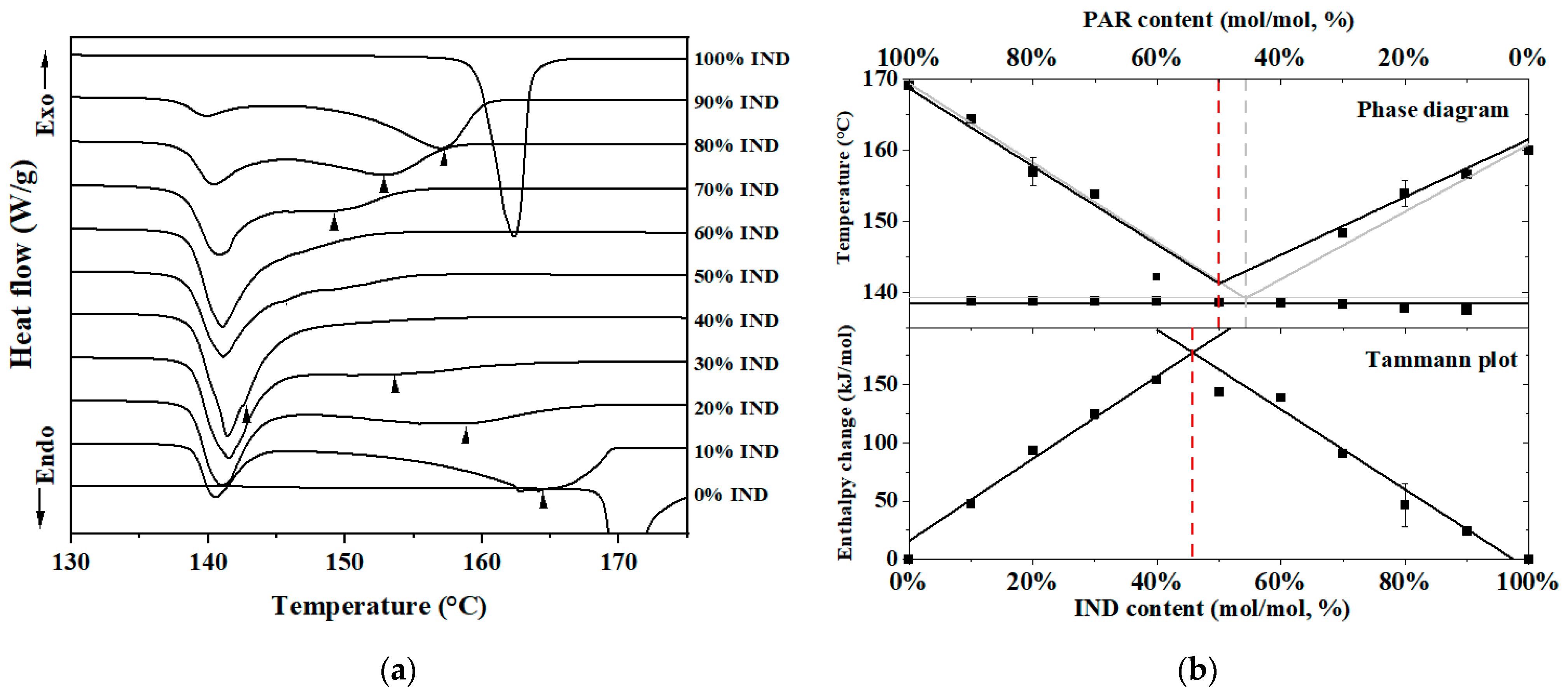

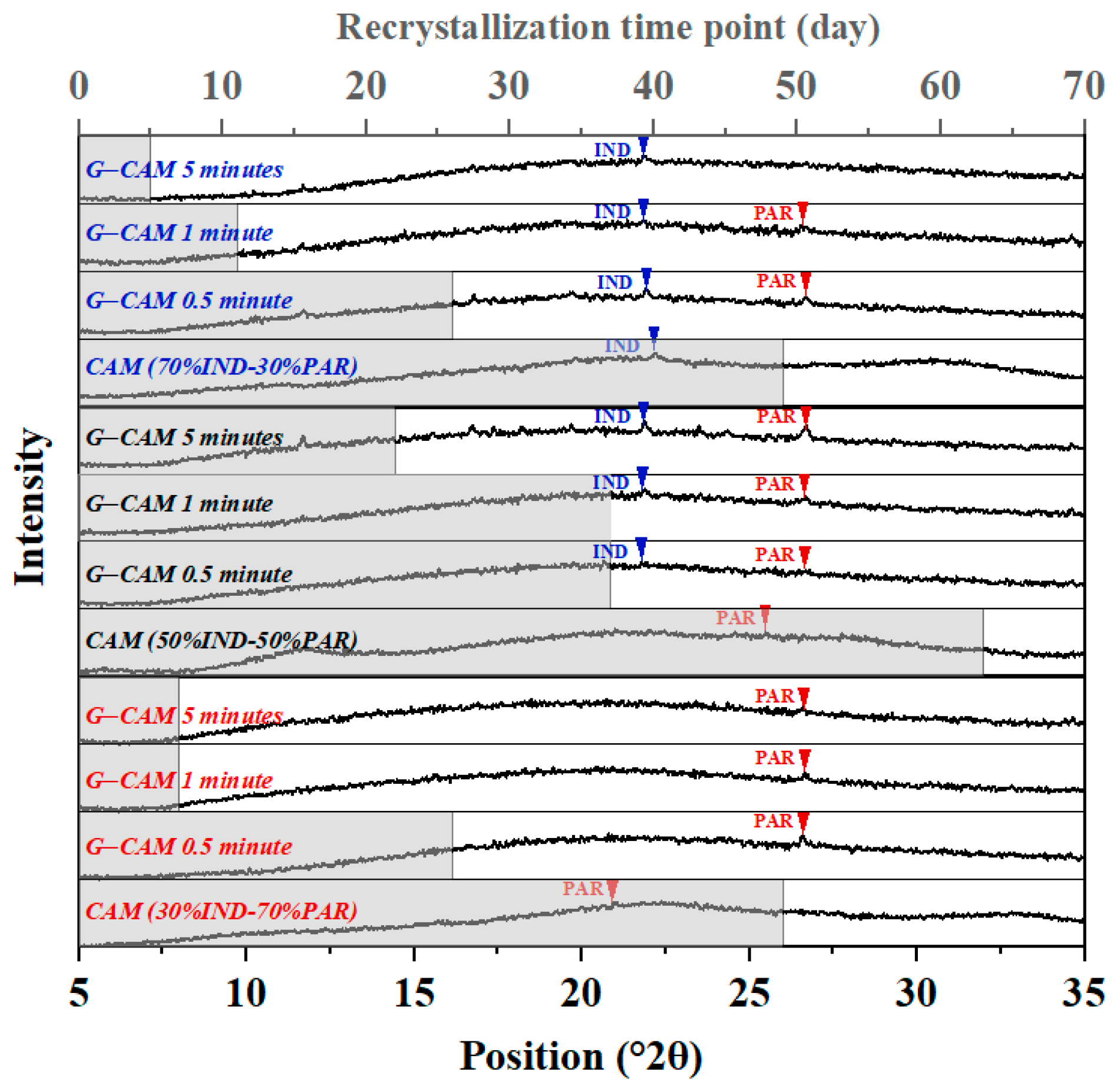
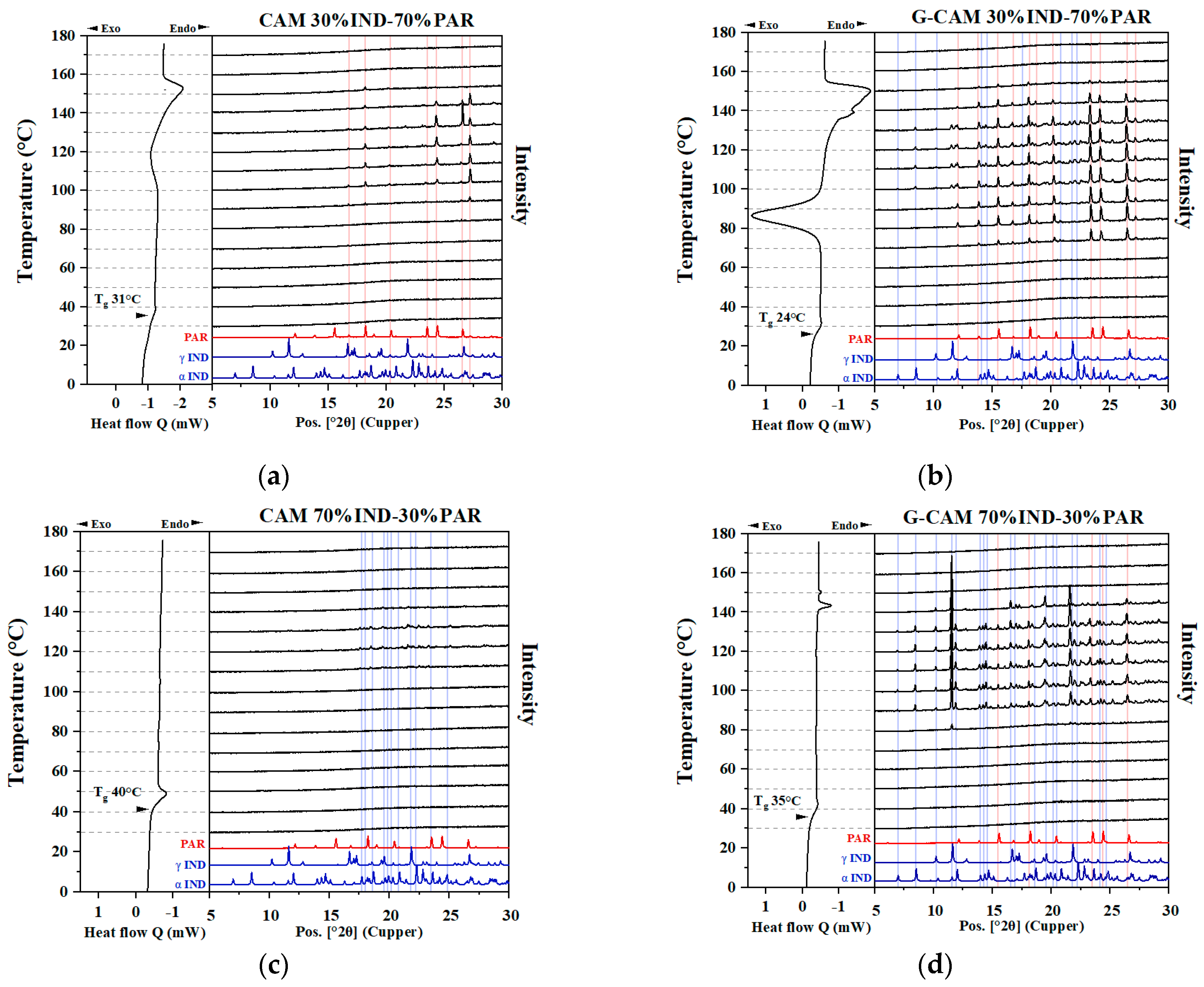
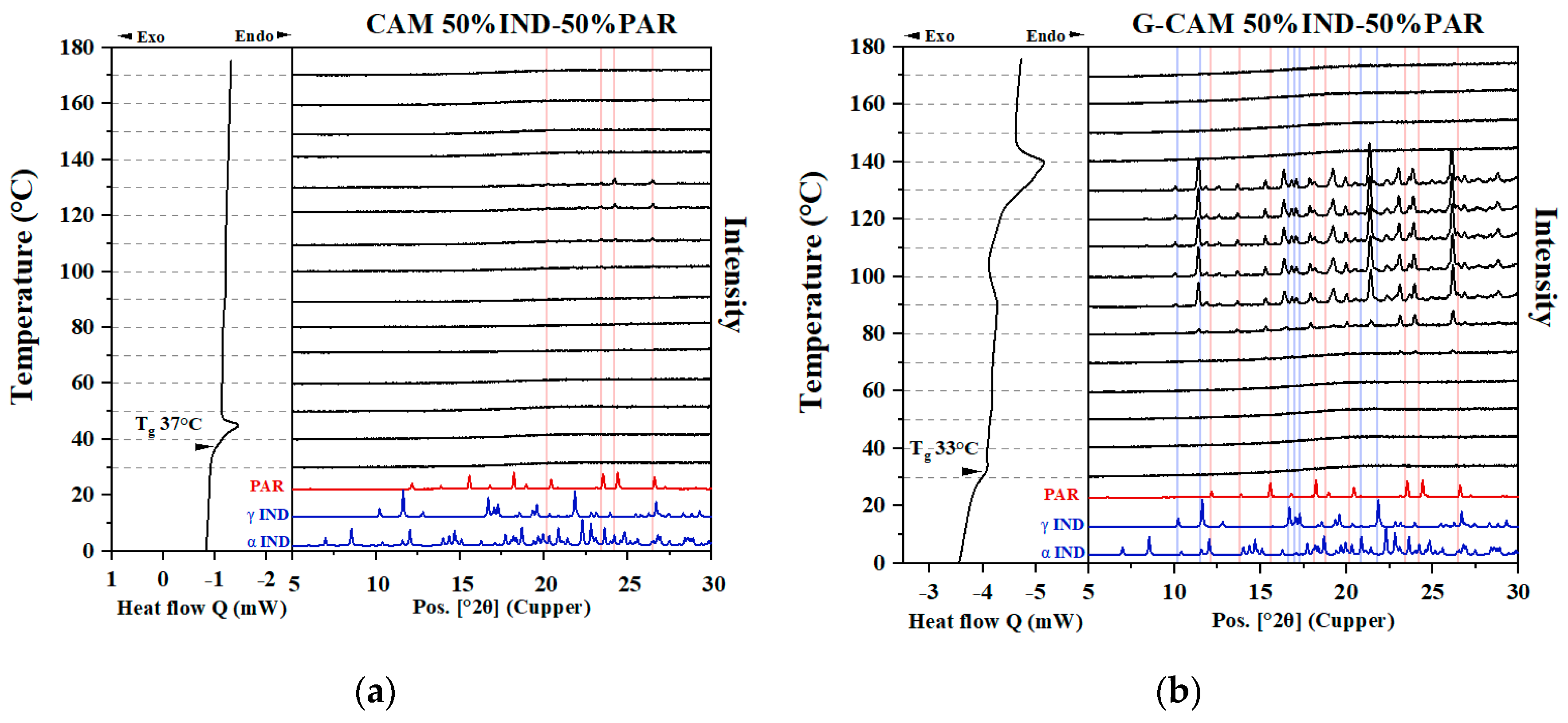


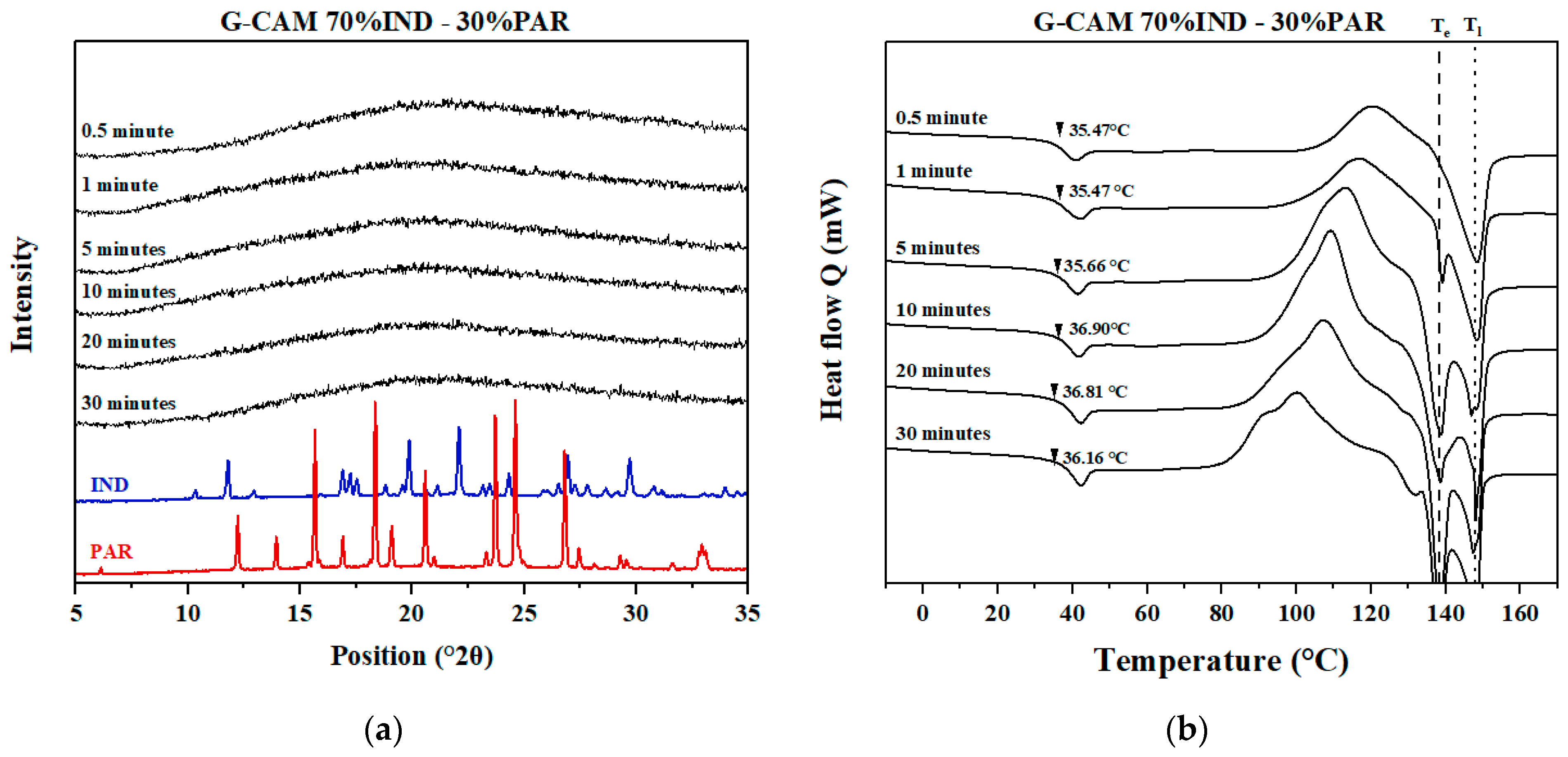
| Sample Composition | Recrystallization Time | Recrystallized Component |
|---|---|---|
| Amorphous IND | 4 weeks | IND |
| 90% IND–10% PAR | 4 weeks | IND |
| 80% IND–20% PAR | 7 weeks | IND |
| 70% IND–30% PAR | 7 weeks | IND |
| 60% IND–40% PAR | 6 weeks | IND |
| 50% IND–50% PAR | 9 weeks | IND |
| 40% IND–60% PAR | 7 weeks | IND and PAR |
| 30% IND–70% PAR | 7 weeks | PAR |
| 20% IND–80% PAR | 2 weeks | PAR |
| 10% IND–90% PAR | 1 week | PAR |
| Amorphous PAR | 0 week | PAR |
| Sample Compositions | CAMS (0 min) | G-CAMS (0.5 min) | G-CAMS (1 min) | G-CAMS (5 min) |
|---|---|---|---|---|
| 30% IND–70% PAR | 0.02% | 0.25% | 0.33% | 0.34% |
| 50% IND–50% PAR | - | 0.35% | 0.28% | 0.34% |
| 70% IND–30% PAR | 0.00% | 0.22% | 0.30% | 0.28% |
Disclaimer/Publisher’s Note: The statements, opinions and data contained in all publications are solely those of the individual author(s) and contributor(s) and not of MDPI and/or the editor(s). MDPI and/or the editor(s) disclaim responsibility for any injury to people or property resulting from any ideas, methods, instructions or products referred to in the content. |
© 2023 by the authors. Licensee MDPI, Basel, Switzerland. This article is an open access article distributed under the terms and conditions of the Creative Commons Attribution (CC BY) license (https://creativecommons.org/licenses/by/4.0/).
Share and Cite
Di, R.; Rades, T.; Grohganz, H. Destabilization of Indomethacin-Paracetamol Co-Amorphous Systems by Mechanical Stress. Pharmaceutics 2024, 16, 67. https://doi.org/10.3390/pharmaceutics16010067
Di R, Rades T, Grohganz H. Destabilization of Indomethacin-Paracetamol Co-Amorphous Systems by Mechanical Stress. Pharmaceutics. 2024; 16(1):67. https://doi.org/10.3390/pharmaceutics16010067
Chicago/Turabian StyleDi, Rong, Thomas Rades, and Holger Grohganz. 2024. "Destabilization of Indomethacin-Paracetamol Co-Amorphous Systems by Mechanical Stress" Pharmaceutics 16, no. 1: 67. https://doi.org/10.3390/pharmaceutics16010067
APA StyleDi, R., Rades, T., & Grohganz, H. (2024). Destabilization of Indomethacin-Paracetamol Co-Amorphous Systems by Mechanical Stress. Pharmaceutics, 16(1), 67. https://doi.org/10.3390/pharmaceutics16010067








